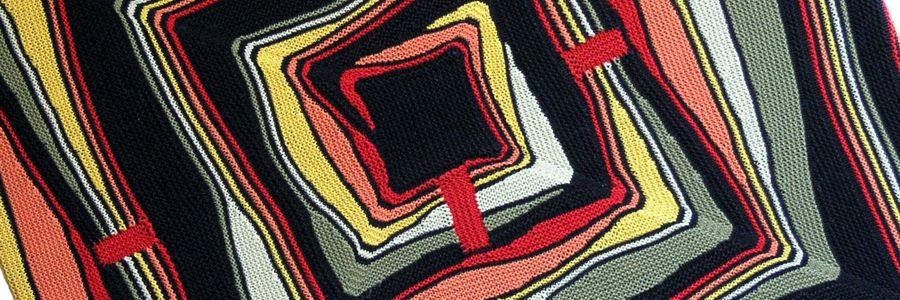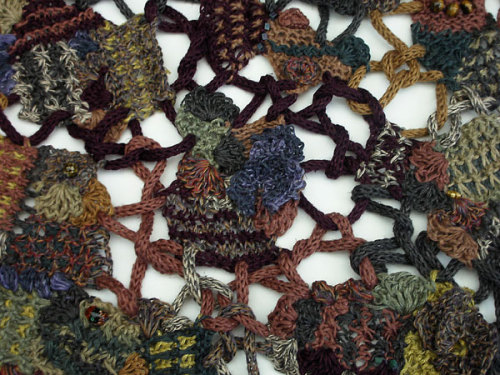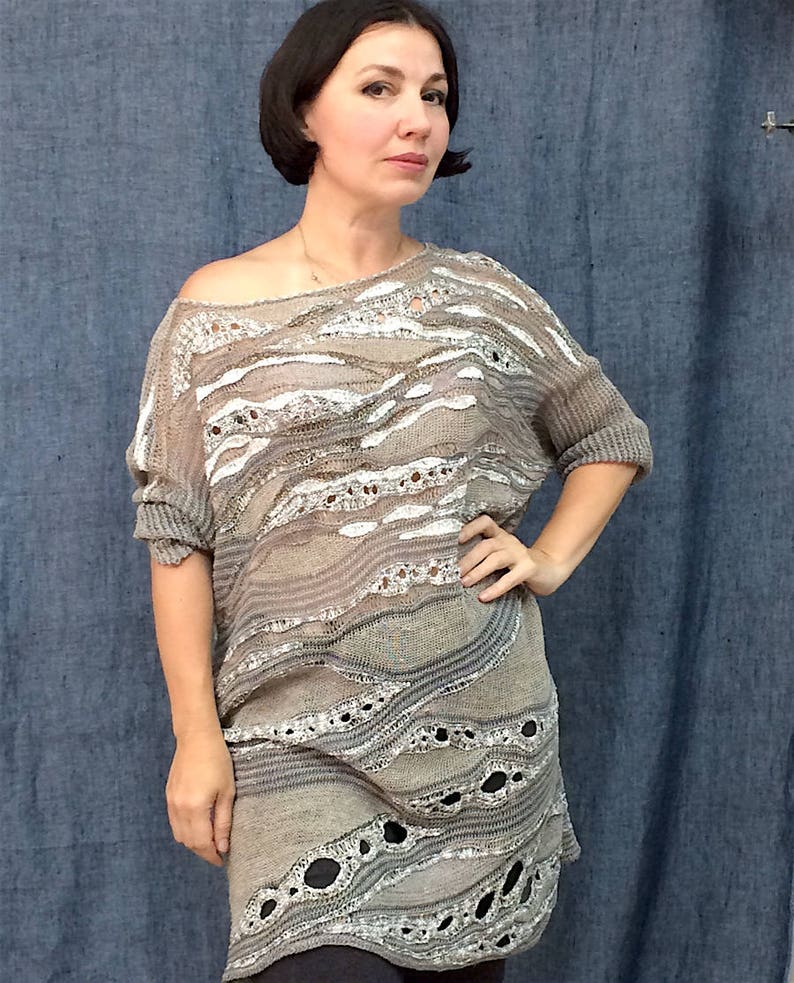 |
| florilegium.com |
Let's start with the dictionary definition of Freeform, shall we?
Freeform (adjective) - not conforming to a regular or formal structure or shape;
having or being an irregular or asymmetrical shape or design.
- Abstract art with yarn and hook or knitting needles
- Yarn painting
- Controlled anarchy and chaos
- Freeform is the demonstration of active choices and skillful creativity by which control has been taken to shape abstract order out of random chaos.
- Knitting (and / or crocheting) in a totally unprogrammed, unconventional way.
- Freeform is the inside of my brain let loose.
- The freedom to create textiles/fabrics, using all possible techniques and fibres, that makes me feel FREE, hence the FREEform in the name
Scrumble based freeform
A scrumble is a small piece of freeform crochet or knitting that can be joined to make a larger piece of freeform work. Traditionally scrumbles are densely worked but they can also be more open and lacy, drawing on empty space as part of their design.
In explaining the origin of the word scrumble, Jame's Walters who coined the word together with Sylvia Cosh says
‘Scrumble’ is a mixture of ‘scrumple’, ‘scrummage’ and ‘amble’ (to name but few), that is, for us it originally described a crochet fabric-making process involving frequent semi-deliberate, optional and speculative decisions with regard to yarn and stitch selection and resulting in more or less randomly shaped and textured pieces. The ‘umble/amble/ramble’ part has the feel of Paul Klee’s ‘taking a line for a walk’ and Jenny Dowde’s adaptation of that, ‘taking a yarn for a walk’, because it’s a process - sometimes you know where you’re going, but mostly you’re wandering and wondering and looking for inspiration, often directly from the piece itself as it appears in your fingers'.
Prudence Mapstone
Website: www.knotjustknitting.com
For a delicious collection of scrumbles look at her blog - A scrumble a weekBeing an Australian, Prudence's work was the first freeform I saw in the wild and she was my first teacher. Prudence is a regular on the Australian craft show circuit and a generous, inspiring teacher. I still have my first incomplete scrumble I made in a class with her and while scrumble based freeform turned out not to be my freeform style, I'm in awe of her work. Her aesthetic is organic and resonates of the natural world.
There is a small group of freeformers who argue that scrumble based freeform is the only true freeform. I vehemently disagree.That's like saying only a particular style of painting is art - rather scrumbling is a 'school' of freeform.
Nell (Elyn) Bray (Artisan Loops)
Nell's true passion is needle lace but her freeform creations are also amazing art pieces. She is also the bullion stitch master.
Asimina Chremos
Asimina is a dancer who creates freeform doilies in her downtime. Her work is a great example of more openwork scrumbling, featuring a colourful fusion of angular and circular geometry and use of large empty space.
You can read more about her work in this article. Asimina Chremos, freeform crocheted doilies
https://asiminachremos.space/crochet-art
Mitsuko Tonouchi
Bonnie Prokopowicz
Bonnie's piece here illustrates a style where a relatively small and consistent vocabulary of stitches are used in a piece. This only uses one stitch - half double crochet (American crochet terminology) worked in the 'third loop' - sometimes called camel crochet. You don't need to be an accomplished crocheter to create amazing freeform - the basic stitches are more than enough.
 |
| Bonnie Prokopowicz Gathering Storm (2018) |
Motif based freeform
In fibreart, a motif is a smaller element in a much larger work. Knit or crochet motifs are made individually and joined together to create larger works. Here we are heading into an area of freeform where patterns are often used to create sub-pieces (the motifs) of a larger work which are combined in an aesthetically pleasing but random or irregular pattern.
Modern Irish crochet
It's often been said that traditional Irish Crochet was the first freeform. Irish crochet is created from small individual motifs on a openwork mesh background. Modern Irish crochet uses a more colourful palette and often thicker yarn. The Russian language crochet magazines Zhurnal MOD and Duplet are great places to find pattern diagrams for motifs and examples of modern Irish crochet freeform.
Given that the Russian crochet community are amongst the best proponents of this style, I apologise that I can't always credit my examples here to a particular maker because of the language barrier and profuse sharing and resharing of images in this community. I've tried to use watermarked photos where possible for this reason.
Encasement
Here the motifs are joined with a denser background encasing each motif, rather than using an openwork mesh.
Freeform Knitting
The jury is much more divided on the subject of freeform knitting - some arguing that there are very few true examples of freeform knitting. Many scrumble freeformers incorporate both knitting and crochet, but freeform which is just composed of knitted fabris is rarer. The linear nature of the construction of knitted fabric with multiple stitches worked on needles at a time lends itself to regular geometry rather than organic curves. Freeform knitting is often perceived as more of a 'danger' - only to be attempted by the brave and adventurous knitter with all those loose stitches ready to escape and run away as you maneuver your work into unaccustomed shapes. It's true that freeform knitting needs more of technical base - a vocabulary of shaping skills such as increases and decreases and short rows and a willingness to work with circular needles or dpns and cast off and pick up stitches. But it definitely exists.
Free range knitting
Designer Jane Thornley describes her work as Free range knitting, rather than calling it freeform knitting. Undulating waves of fabric are created using short rows and there is an encouragement to 'paint' landscapes with yarn but this often still progresses in a fairly linear fashion. These full width linear pieces aren't always recognised as true freeform.
 |
| River run wrap by Christie Furber |
 | |
| Peacock Furls Wrap by Jane Thornley. This piece with its modular semicircular construction is much more recognisable as 'freeform' |
 |
| Shorelines by Jayne Thornley |
Shortrows
Shortrows are the tool that really opens up possibilities in freeform knitting.
 |
| Shell Canyon by Debbie New from Knitting Art by Karen Searle |
 |
Barbara Lawler (Newform) - Testing the Waters |
Swing knitting is a unique technique of short row knitting using the rhythms of music to develop repeatable short row patterns which swing and dance through the piece. Ah, but it's repeatable you say, not strictly freeform as it's not irregular patterning. I'd argue that that this is an immensely useful techniques in a knit freeformer's arsenal and that the results can delightfully blend regular and irregular.
The main technique is doing a start short row with always the same amount of stitches (the melody width) and moving it, using a mathematical sequence of numbers (the knitting melody) for each short row field (stanza) of your work. This knitting melody can be 1,2,3,4,5 or any math sequence you invent, and you follow it throughout the whole work.
 |
| Gabriele Kluge |
 |
| Fadenzaubereien |
Crazy Quilt Knitting (Myra Wood) and Patchwork knitting (Horst Schultz)
Horst Schultz pioneered 'Patchwork Knitting' (see his book of the same name), connecting smaller knitted patches into larger pieces. Even though his work consists of repeated regular motifs and isn't strictly freeform, his work is unique in that he strayed beyond strictly right angle geometry to work with curved pieces. Myra Wood translates traditional crazy patchwork into knitwear.
 |
| Myra Wood |
This is really just dipping a toe into the possibilities of freeform.
I've barely skimmed the surface and haven't even mentioned freeform lace knitting or Myra's Wood's crazy lace. I also haven't dived into pictorial crochet and knitting or knitted or crocheted portraiture (which may or may not be true freeform).
Suffice to say, taking your needles and hooks and yarn to play off the beaten track opens a world of possibilities.























No comments:
Post a Comment
I'd love you to say Hi. It's so much fun hearing from my cyber friends.